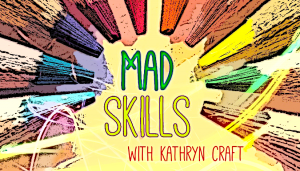Business
Warning: Hacks for Hacks tips may have harmful side effects on your writing career, and should not be used by minors, adults, writers, poets, scribes, scriveners, journalists, or anybody.
Most writers dream of making it big. But what does “making it” mean, exactly? The answer is different for everyone. There are lots of resources about how writers can make money and improve their craft, but today I want to focus on every writer’s purest motivation: to gain the validation, attention, and admiration of important and attractive people. That’s right, Famous Author Bill Ferris is talking about your level of famousness, which is a healthy and totally controllable thing for you to fixate on.
[Note that I’m differentiating between fame and success here. While a small handful of folks like Stephen King and J.K. Rowling have both, many writers have one without the other. Financial success is outside the scope of this column, but to find out more information on how to get rich as a writer, just Google “writing” and click on literally any search result.]
Writing is a never-ending and non-lucrative job, and if we can’t get paid in money, then we should expect to sign a few books for readers, to get recognized when going through the Drive Thru, or at the very least get some “likes” on social media (which is the true coin of the realm in the influencer economy or whatever).
To find your ideal level of fame, we need to identify what type of writer you are.
Type Zero: Fame? What’s That?
Motivation: You write what you write, and people can like it or not. You’re just doing this for you.
Ideal fame level: Your boss knows you write during your lunch breaks, but doesn’t take that as an indication that you’re slacking off on the job.
How you’ll know you’ve achieved it: You’re either a wild success or unpublished, and in either case, you’re already at your ideal level of famousness. So take your emotional maturity and well-adjusted priorities elsewhere, because the rest of us divas are trying to make a breakthrough here, okay?
Type 1: The Bestseller
Motivation: You want to get booked on every morning show, and go on months-long publicity tours so you can get laid in every time zone. You have an insatiable hunger for praise and validation, for someone, anyone to notice me. Er, I mean you.
Ideal fame level: You can’t leave the house without someone approaching, photographing, or cursing at you.
How you’ll know you’ve achieved it: 1. You’re a guest on a book podcast, and the host has actually read your book. 2. The subject(s) of your infamous tell-all book will no longer speak to you.
Read MoreIn Puerto de Mogan on Gran Canaria. Image – iStockphoto: Mustang
The Elusive Chapters of Summer
Part confession and part inquiry, today’s little provocation for you is about a long-running fantasy I’ve nourished since my late teens: the idea of a summer vacation on which you make big progress on your work-in-progress.
Being born into a family of tireless workers, I was quite young when I seized on the phrase “working vacation.”
I tweaked it with the concept of getting off to some picturesque spot in the world where I’d spend a week churning out about a chapter an hour while fabled breezes ruffled my hair and cooled my busy brow. A writing vacation.
Sometimes I’d try one of those “writing retreats” in a stately home next to some really good vineyards. You can imagine how well that worked out. Inevitably, the retreat trips were the worst, even if not near the grapes, because they’re always run by strangely punitive “instructors” whose work no one has ever read and who over-schedule everything to within an inch of your sanity.
No, going it alone always proved the best idea. And surely, I reasoned, I’d return, triumphant, a full manuscript in hand, ready for light edits and then quick distribution to adoring agents. So I tried this writing vacation thing
The part I got right was about the hair ruffling, My hair was really very well ruffled by some of the most fabled breezes in the world–off the Atlantic, the Mediterranean, the Ionian, the Aegean, and a couple of disturbingly deep lakes.
But the writing?
Read MoreAuthor Anne O’Brien making friendship bracelets.
In this week’s Author Up Close, I interview Anne O’Brien Carelli, author of adult nonfiction, the middle-grade book Skylark and Wallcreeper, and the picture book Amina’s New Friends. She’s been a friend and mentor since we met at our first Writer Unboxed conference. Anne is the owner of a leadership training business, and she has taught me invaluable lessons about managing the craft and business sides of being a writer. Her advice will be especially helpful to anyone writing and querying middle-grade or YA fiction, and she’s a great example of using the skills you’ve learned in previous careers in your career as a writer.
GW: How did you find your agent and land your publishing deal?
AOBC: I had published two nonfiction adult books and self-published a picture book, but the children’s traditional publishing world was new to me. I soon discovered that writers who want to publish a children’s book need to have perseverance, blind optimism, a desire to hone the craft, and a belief in serendipity. It also helps to pay close attention to what is published in your genre.
I found my agent by chance. As I was researching an editor I admired at a conference, I came across a description of her colleague, who looked like the perfect match for my middle-grade book, Skylark and Wallcreeper. I had rewritten my query a million times, but tried again.
I think it’s really important to investigate what agents like to read, what they are looking for, and what types of books they have represented in the past. You can learn a lot of this information by attending conferences and signing up for short consultations with individual editors and agents.
As for landing the publishing deal? I give my agent all of the credit for that. She also looked for the right match and Little Bee Books has been a wonderful home for my book.
GW: Why did you decide to write middle-grade fiction, and why this subject matter?
AOBC: There was never any doubt that I would eventually write middle-grade fiction. The picture book was written because I have volunteered with refugee children for many years and saw that the story about a refugee girl’s first day in an American school was desperately needed. The textbooks I published were related to my work in gender equity and leadership. But many eons ago I taught sixth grade and social studies, and middle grade is my favorite age group (ages 8-12). Those kids are just on the cusp of figuring out who they are, and are developing independence and coping skills. middle-grade books, especially in the last two or three years, address a number of tough issues that kids are facing today. But every middle-grade book has hope at the end, and that appeals to me.
Read MoreImage – iStockphoto: Kagenmi
Springtime for Scholastic
Here on the first day of July (rabbit!), you may have missed the news in the latter part of June that something tentatively called the Untitled Panem Novel is to be rolled out in print, ebook, and audiobook editions in the States, Canada, the UK, Ireland, Australia, and New Zealand on May 19 of next year– a nice big simultaneous release in many countries, something that’s beloved of us publishing internationalists.
Do you know what Panem is? If so, then you know your Hunger Games. Panem is the post-apocalyptic nation featured in The Hunger Games.
And in an understandably delerious news flash to the media, Scholastic has announced that Suzanne Collins’s new Hunger Games book is a prequel to the trilogy, the first book of which started reaching the reading public in 2008. Time flies like a Katniss arrow when your first book in a trilogy is on the Times bestseller lists for more than five years running.
The second book in the trilogy, Catching Fire (history’s most understated wink of a title), was out in 2009.
Mockinjay, the capper, came out in 2010.
So it will have been 10 years since the appearance of the third Hunger Games book when the new title arrives. Nostalgic, are you?
Scholastic is telling us that international rights for the trilogy have sold into 54 languages and 57 territories. In fact, the rights for the new prequel already are reported to have sold into Brazil, Israel, Norway, Spain, Slovakia, Germany, Hungary (no Hungary Games jokes, please), Finland, and France.
There are more than 100 million copies of the books from the trilogy out there. The four films have pulled in almost $3 billion since the first one went to the cinemas in 2012.
And the reason I’m going on about Collins’ work and the upcoming prequel–which is set 64 years before the trilogy on the morning of the reaping of the 10th Hunger Games–has a lot to do with a book market that has needed some YA crossover energy for a while. Badly.
It was during the long-running popularity of The Hunger Games that Nielsen first revealed data indicating that an astonishing 80 percent of YA titles were being bought for consumption by adults.
This is one reason that a lot of people may feel cheered by a new arrow from Collins’ quiver. As BookScan research (formerly a Nielsen product, now owned by NPD) revealed at BookExpo, the bestselling genres in adult divisions this year are general fiction and suspense/thrillers. Romance came in third in the first quarter of this year. In kids’ and YA titles, the best 2018 fiction sales seen in general fiction, sci-fi, and fantasy.
All of which indicates that action-adventure/fantasy/thriller-driven material like that Collins creates can still find a lot of traction, particularly among the Panemites of our readership.
What’s more, while nonfiction may still be hitting more growth charts than fiction these days, NPD did see a distinct fall-off in the first quarter in political book sales. (That caused a nearly audible gulp from publishers at BookExpo who had just signed new political books.) A slacking-off in the sector isn’t yet known to be long-term […]
Read MoreUnder the pen name Anna Schmidt, Jo Schmidt has written over thirty novels that have collectively sold over half a million copies. She is also the author of Parkinson’s Disease for Dummies and several books on eldercare published by AARP. Her latest novel, The Winterkeeper (March 2019) is her first literary fiction release. A former marketing and communications professional for two international corporations who has also taught at the college level and run a Mom-and-Pop adult daycare business with her husband, Jo is now retired and focused only on writing. She splits her time between Wisconsin and Florida.
—
Breaking out of the Genre Pigeonhole: Tips From a Romance-Turned-Mainstream Novelist
When the love of my life died seven years ago, it was like losing half of myself. Aside from the deep emotional toll grief takes, it brought professional challenges. As a career romance author, writing love stories suddenly became downright painful.
For years I had been contemplating breaking away from the genre fiction mold I’d been embedded in for decades, but now, moving away from romance fiction felt vital. I no longer wanted to write ‘happily-ever-after’ stories. I wanted to write ‘what-happens-next’ stories. I was fascinated with telling the story of a marriage after the honeymoon—years, even decades after. I now knew that story—the laughter and the tears of that story.
Many writers, myself included, start their careers with a singular quest: to get published. It follows the outline of the “if a tree falls in the woods” adage: You can work day and night on a manuscript, but if it never reaches readers, did it ever really get written?
If you’re lucky, you might get published. You may even have a bit of success, as I did. And I learned an important lesson: With success comes restrictions. I had sold over 500,000 copies of my romance works. How hard could it be to pivot away from romance, to be able to tell the more complex stories I wanted to tell?
The answer: Hard. Very, very hard. In the end, publishing is a business. Turning out romance novels for the legion of readers is big business. Having worked in the corporate world for two international companies, I understand that bottom-line philosophy. I don’t have to like it; I just understand it. And the bottom line was that these publishers needed me to keep writing the stories that would feed the appetite of genre readers and drive consistent, predictable sales.
So when it was time for a change—or at least a shift—my agent pitched my new novel concept to a number of publishers…and I got some of the nicest rejection letters I’ve ever received in all my years doing this writing thing. They liked the story, the writing, the characters. But they couldn’t see a viable route to cash in.
Luckily, my skin was thick, and I learned a lot. If you find yourself in a similar position, hoping to reinvent yourself as a writer and storyteller, here’s what you can do:
Read MorePlease welcome Lisa Barr to WU today!
Lisa is the author of the upcoming novel, THE UNBREAKABLES (Harper) releasing on June 4th. The book promises to be, “A delicious, sharp novel about a woman who jets off to France after her perfect marriage collapses, putting the broken pieces of herself back together while rediscovering her own joie de vivre—a lust for life, art, and steamy sex.” Publishers Weekly said of the book:
“This exquisitely wrought novel will appeal to readers who believe in the redemption of new beginnings.”
The story itself creates the jumping-off point for today’s blog post, because it wasn’t entirely made up. How did Lisa turn a real-life event into something fit for the fiction section of the bookstore? Read on! But first, a bit more about Lisa, from her bio:
Lisa’s debut, FUGITIVE COLORS–a suspenseful tale of stolen art, love, lust, deception and revenge on the “eve” of WWII–won the IPPY gold medal for “Best Literary Fiction 2014”, first prize at The Hollywood Film Festival (Opus Magnum Discovery Award), and was named on “HEEB” magazine’s “Top 10” best books list. According to Booklist, FUGITIVE COLORS is “masterfully conceived and crafted … a dazzling debut novel that has it all: passion and jealousy, intrigue and danger”.
Earning her master’s degree from the Medill School of Journalism, Northwestern University, Lisa has served as an editor for The Jerusalem Post, managing editor of Today’s Chicago Woman, managing editor of Moment magazine, and as an editor/reporter for the Chicago Sun-Times.
For more, visit lisabarr.com.
When Your Story Hits Too Close to Home
In 2002, this happened. My first husband, to whom I was married nine years, disappeared. He left me with two little girls, then five and three, with just 67 cents in my bank account. We have not seen nor heard from him since then. Oh, the story …. the twists and turns … along this nightmare, from despair to survival. Once our lives had finally quieted down, I knew I wanted to write about it. But this tale was not just my life, but my girls’ lives … could I write it? Should I? What would be the consequences? So I waited until my daughters were old enough to really understand. “Can I write our story?” I asked them both. “Yes,” they replied. So I spent the next year and a half writing a memoir. Once I finished it, my eldest who was entering high school at the time, said, “I changed my mind, Mommy. Please don’t write that book – it’s so embarrassing.” And so it goes … the memoir was shelved, but not the story, not the impact of what it did to me, did to us. The written story was dead, but the emotions were still very much alive and I used them within other works.
Flash forward to 2017… a close friend’s husband betrayed her in the worst possible way. “Can I write this story?” I asked her, intending to fictionalize it but keep the soul, the emotional intensity. “Yes,” she said generously, but then I saw the fear in her eyes. “I will show it to you,” I promised. “I will work […]
Read MorePlease welcome bestselling author Randy Susan Meyers to Writer Unboxed today! Randy’s latest novel, WAISTED, tackles the hot and important topic of body image. More about Randy from her bio.
Randy Susan Meyers’ novels are informed by over twenty years working with criminal offenders and families impacted by emotional and physical violence. With Waisted she tackles an issue both personal and political: body image.
Reviewing Waisted, Booklist wrote “Meyers exquisitely explores body image, family, and marriage in this surprisingly deep novel. Though she starts with a fictionalized version of the TV show The Biggest Loser, she dips into major issues of race, culture, obsession, and sisterhood. Taking on the timely topic of how a woman is perceived in today’s society, she twists it into how far women will go to be what society deems right, and at what cost—a marriage, a family obligation, a personal goal? A compelling story that will leave readers giving their scale the side eye.”
Waisted has been chosen as a Top 2019 Summer read by Parade Magazine, Pop Sugar, BookBub, Women.com, Get Literary, and Brit.Com. Kirkus Review wrote, “Meyers spins a compelling tale, raising critical questions about familial, social, and cultural messages about body image . . .” and Library Journal said “Meyers delivers a timely examination of body image, family, friendship, and what it means to be a woman in modern society. It will appeal to anyone who has ever dreaded stepping on a scale; even those who haven’t will learn from it. Culturally inclusive and societally on point, this is a must-read.”
Meyers is a Brooklyn-Boston mix who believes happiness requires family, friends, books, and an occasional NY bagel. She lives in Boston with her husband where she teaches writing seminars at Boston’s Grub Street Writers’ Center.
Randy’s post offers some words of wisdom–and humor–about something all published authors have to grapple with eventually: bad reviews. Enjoy!
Soothing Words for Bad Reviews
It was the best of times; it was the worst of times.
I’m talking about launch time, of course. By the time this essay is published, my newest novel, Waisted, will be out in the world. As will the reviews. From the trades, magazines (perhaps,) newspapers (maybe,) bloggers, members of Goodreads, library thing, librarians, Amazon, Barnes & Noble, Audible, iTunes customers, and, most likely, my auto mechanic.
This time around I’m especially nerved-up. Waisted is the most polarizing book I’ve written. For every fiercely feminist, urgent, darkly humorous, compelling and wickedly fun, observation, I’m piling up knife-like words that indict me for even attempting to write down the inside thoughts of women reacting to a world that treats fat women as pariahs.
And do I respond, as many have written, with mature acceptance of the varied opinions of the world? Do I try, as many have written, to learn from what they write? Do I sigh and think, well, that’s their opinion?
No, I do not. I react like a slug sprinkled with salt. Honestly, one mean (meaning the reviewer didn’t love it) review can overtake reading fifteen filled with accolades.
Upon reflection of said mean reviews I do not cull the wisdom therein. I think of what my next career will be. Certainly, it will be a hermetic vocation that won’t even make the pages […]
Read MoreIn a previous post, I wrote about the ‘red lines’ that authors and publishers alike might encounter in book contract negotiations. In this post, which like the earlier one is drawn from a conference paper I presented late last year, I look at another important question for authors: Are big or small publishers easier to deal with when it comes to contract negotiations?
In my home country of Australia, the size and importance of the small and independent press sector has grown exponentially in recent years, which means that more authors and agents are working with small presses than ever before. In the paper, I presented interviews with authors and agents who had worked with both big and small publishers, focusing on how they viewed the contract negotiation experience. The answers offer some illuminating insights on the contrasting experiences and opinions within the industry:
‘Most publishers have a take it or leave it attitude to contracts. The bigger the organisation, the more they exert their will in terms of the details within the contract.’ (author-illustrator)
‘Small publishers are generally more nimble and flexible and are often less intent on holding certain rights so we’re generally able to reserve more for the author. Having said that, there are some small publishers who are inflexible on their terms because of their business model and that can be off putting for creators and/or agents.’ (agent)
‘I have found there has been more room to move in contract negotiations with larger publishers than small. The smaller the publisher, the more limited the budget, the less room there is to move with regards to money. But I have negotiated things like future writing work clauses, division of rights, and the number of copies I get.’ (author)
‘It’s not size but the company. For instance, taking two of our biggest publishers – one is very difficult to negotiate with and has a very hard-line approach, which is actually a disincentive to pitch to them at all, and another is always fair and reasonable to negotiate with – not a pushover, but you know you’ll get a straight answer. Many smaller publishers are great to negotiate with – they know their business and where they can bend, but a few use their small size to (wrongly) try to justify very poor terms for authors indeed.’ (agent)
Read MoreHave a novel or writing-related service you’d like to promote on Writer Unboxed? Bid on this package and receive a traditional two-week ad run at Writer Unboxed, along with our more experimental “ad post,” to be pushed out to our feed and email readers.
More about the ad
Writer Unboxed receives thousands of hits daily. This means thousands of potential eyes on your ad—the eyes of serious writers who are also avid readers.
More about the ad post
In addition to our site’s traffic, WU has over 7,000 subscribers on Feedly and reaches over 5,000 email subscribers. We’ve recently begun experimenting with ad posts and have learned that they may be our most powerful offering. We’ll rejigger our ad menu in the coming months to offer more ad posts, but in the meantime you can win this perk for yourself.
Here are a few examples of recent ad posts that have done well by our advertisers, to give you a sense of what this may look like for you:
Terms
Read MoreThis happens more often than I’d like to admit: I’m sitting around with friends or acquaintances or random strangers, and the fact that I’m a writer comes up. (I never noticed before just how often people say, “What do you do for living?” until I started answering that question with “I’m a writer.”) From there the conversation usually moves to what genre I write, what I’ve published, when my next book is coming out, and then like a hand grenade tossed into my lap: “What’s your book about?”
I freeze. My brain sets off alarms that sound all over my body. Panic sets in. I try to buy time by saying, “Wellllll,” and “Uuuuummm,” and “Okay, sooooo.” My first book was published seven years ago, my fourth novel is coming in August, and this still happens every time someone asks me what my book is about. When I received a PR Q&A from my publisher with the question “what is your book about?” I may have yelled out loud, “Don’t you people have a whole sales department to tell me what my book is about?”
Part of this difficulty is related to many writers’ struggles with query letters and elevator pitches. After you’ve spent months or years crafting a complex and nuanced story, now you’re supposed to boil it down to a few sentences? I’m terrible at this in part for the same reason I write novels instead of flash fiction.
The other part of why this question is so hard for me is about the panic and how my brain responds to it. More than one person has suggested that I should just memorize my official pitch word for word. Sadly most of the time the panic wipes my brain clean, and all I can find in my Things I’ve Memorized file is a few random Bible verses and the Pledge of Allegiance. Even on the occasions when I successfully regurgitate what I’ve memorized, I just sound like a malfunctioning robot. If I’m supposed to be selling my book to potential readers, that is not the way to do it.
I wish I could tell you that I have found the solution to this problem, and that you can read about it after the jump, but the truth is I choked on my one and only attempt to pitch a novel to an agent in person twenty years ago, and I choked again this last week.
I was at a gathering of booksellers and inevitably I was asked the question about my forthcoming novel. Cue panic, followed by me opening my mouth and having a few hundred words fall out in no particular order. I’m here to tell you that this is not ideal, but it’s also not a complete catastrophe. After all The Princess Bride has been successfully selling itself with a pile of random words for many years: “Fencing. Fighting. Torture. Poison. True love. Hate. Revenge. Giants. Hunters. Bad men. Good men. Beautifulest ladies. Snakes. Spiders. Beasts of all natures and descriptions. Pain. Death. Brave men. Coward men. Strongest men. Chases. Escape. Lies. Truths. Passion. Miracles.”
All this to say that my wisdom is much more philosophical than practical. Over […]
Read MoreI recently started a Scrivener Q&A column for my newsletter subscribers. One reader, Avril, asked how to determine which features you really need and which ones are distractions.
For example, she’d color coded her scene documents with Labels at one point because she learned how and it looked cool, but it didn’t really serve her process other than to make the Binder (list of scenes/chapters) look pretty.
Obviously, which of Scrivener’s tools are useful—or only useful for procrastination—depends on what and how you write. And it may change from project to project.
To help you figure out what’s right for you, I’ve developed a Writer Unboxed-exclusive, not-so-scientific, three-stage plan for getting the most out of Scrivener without getting overwhelmed. It’s what I preach to my private students and in my workshops, and I hope you find it useful for learning anything new.
1. Start by learning the basics so you can at least use Scrivener to write.
This requires a little time and discomfort upfront, but you’ll be better able to judge Scrivener’s value if you can actually use it. To get started, check out the free tutorial that comes with the software, but don’t worry about memorizing everything or even finishing the tutorial right now. Think of it as a nice introduction to what Scrivener can do, not something you must commit to memory before you can start working.
2. Learn the features that got you excited to switch to Scrivener in the first place.
Maybe it was the Corkboard for storyboarding, maybe it was tracking your progress, or maybe it was just being able to see the structure of your story in the Binder as you build it. Whatever it was, learn those functions as soon as possible so you’ll be able to get what you wanted out of Scrivener in the first place and be happy with your choice to switch .
3. Add more tools to your repertoire as your comfort level builds, or as needs dictate.
It’s good to focus only on what you need so Scrivener doesn’t become a distraction from what really matters: writing. But, it’s also helpful to know what Scrivener can do so that when you want a capability, you already know there’s a solution. Honestly, if you think it should exist, there’s a 91% chance (totally made up number that reflects my anecdotal experience) that it does exist.
In my blog posts, workshops, and classes, I try to highlight what I think are the most useful features. Not so you feel like you have to know/use all of them—I sure don’t—but so you know they exist in case you ever want them.
Avril didn’t find color coding helpful in her past projects, but what if her next one requires her to submit and then edit portions of the manuscript while she’s still writing other chapters? A quick visual aid for the status of each section might save her sanity. (I speak from experience.)
So, stage 3 is for those who say, “I’ve been using Scrivener for months/years, and I like it,
Read More




















